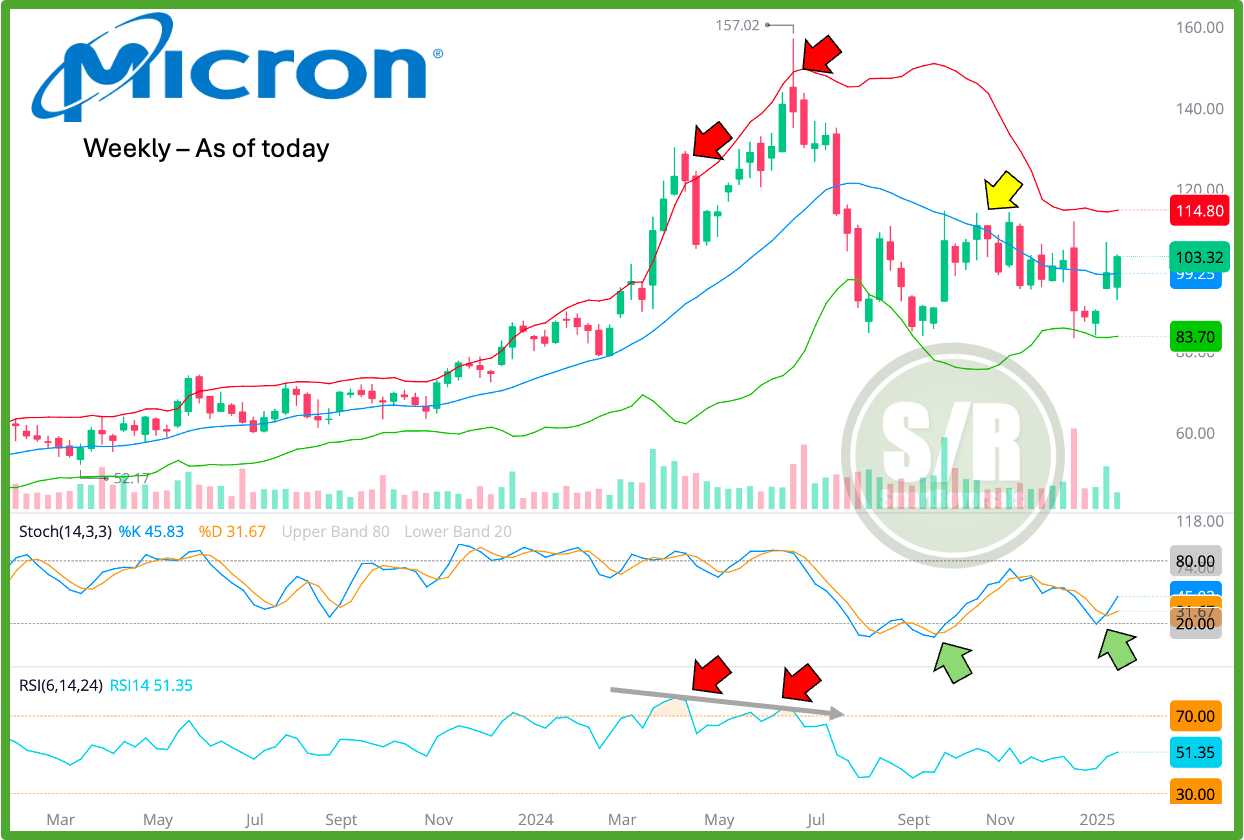Navigating the Semiconductor Landscape: A Fundamental Perspective on MU, TXN, and INTC
Semiconductors, a cornerstone of the modern digital age, is a dynamic and complex landscape characterized by rapid technological advancements, cyclical fluctuations, and intense competition
Understanding the forces that shape this industry, and the specific dynamics of individual companies is crucial for investors seeking to navigate this challenging terrain. This analysis delves into the semiconductor industry, focusing on three key players: Micron Technology, Texas Instruments, and Intel, providing a fundamental perspective on their strengths, weaknesses, and future prospects.
Some market commentary before starting:
Unlock Market Opportunities with Unmatched Precision
Last Saturday, the Weekly Compass provided key targets across U.S. indices, stocks, commodities, and Bitcoin. This analysis proved remarkably accurate, hitting targets in the vast majority of cases. Unlike publications that limit their scope to the SPX, the Weekly Compass offers a truly comprehensive view, analyzing over 20 charts each weekend and 35 securities every Friday. This gives you a distinct market edge, providing a complete menu of investment opportunities you won't find anywhere else.
Consider these recent results after the latest publication:
IWM: Bearish Target: $212 | Actual Low: $213
SMH: Bearish Target: $240 | Actual Low: $240
SPX: Bearish Target: $5749 | Actual Low: $5773
AAPL: Bearish Target: $237 | Actual Low: $229
NVDA: Bearish Target: $129 | Actual Low: $129
GOOG: Bearish Target: $189 | Actual Low: $188
Bitcoin: Bearish Target: $88K | Actual Low: $87.7K
TSLA: Bearish Target: $376 | Actual Low: $380
MSFT: Bearish Target: $411 | Actual Low: $411
GLD and SLV are on track to reach their bullish targets, PLTR was likely to bounce on Monday before the target was hit, hence my chart posted in Substack notes and X/Twitter that day since I know many subscribers like that stock. Indices like DJI and NDX moved down as expected, bouncing slightly above their targets.
This level of accuracy, combined with an extensive market coverage, empowers you to make more informed investment decisions. Discover how to read the current price action in SPX and the market in general below the fundamental analysis promised for today. Unlock the premium content today for the complete fundamental content and market analysis!
The Semiconductor Industry: A Foundation of Innovation
Semiconductors, the tiny chips that power our electronic devices, are essential components of modern technology. From smartphones and computers to automobiles and industrial equipment, semiconductors enable the functionality and connectivity that drive our digital world. The industry is characterized by:
Rapid Technological Advancement: The relentless pursuit of Moore's Law, which predicts the doubling of transistors on integrated circuits every two years, drives continuous innovation and miniaturization.
Cyclical Nature: The semiconductor industry is known for its cyclical patterns, with periods of strong demand and high prices followed by periods of oversupply and price erosion.
Intense Competition: The industry is highly competitive, with major players vying for market share and technological leadership.
Geopolitical Influences: Semiconductor manufacturing is often concentrated in specific regions, making the industry susceptible to geopolitical tensions and trade disputes.
Micron Technology: Riding the Waves of Memory
Micron Technology (MU) is a leading provider of memory and data storage solutions, specializing in DRAM, NAND, and NOR flash memory. These essential components are found in a wide range of applications, from consumer electronics to enterprise servers and automotive systems.
Texas Instruments: Analog and Embedded Expertise
Texas Instruments (TXN) is a leading analog chipmaker with a broad portfolio of semiconductor components, including digital signal processors, high-performance analog devices, and embedded processors. The company serves diverse end markets, with a strong focus on industrial, automotive, and communications infrastructure applications.
Intel: Navigating a Transformative Period
Intel Corporation (INTC), a longstanding leader in the semiconductor industry, is navigating a period of significant transformation and challenges. While renowned for its microprocessor design and manufacturing capabilities, the company faces intensifying competition and evolving market demands.
Micron Technology, Inc. (MU) is a leading provider of memory and data storage solutions, critical to advancements in artificial intelligence, 5G networks, and cloud computing. As the only US-based memory manufacturer and a top-three global supplier, Micron holds a strategic position within the semiconductor industry. The company specializes in DRAM, NAND, and NOR flash memory, essential components for a wide range of applications, from consumer electronics to enterprise servers and automotive systems.
The weekly chart presents a good reference of how a top is formed, the red arrows highlight a bearish divergence with the Relative Strength index that moved down the stock from the higher Bollinger band to the lower one, bouncing once the green band was breached and the Stochastic was oversold. The relevance of the 20MA (blue line) is remarkable, the yellow arrow presents rejections from that zone.
Good news for bulls, the 20MA has been recovered, that line must hold price to consider bullish continuation to $108, and potentially $121. Let’s study the fundamentals so risk can be assessed also based on MU’s business context.
Most of the fundamental analysis is open for everyone, so you can have a reference of what can be unlocked for 40 companies including TSLA, NVDA, SHOP, JPM, NFLX, LMT, BA, WMT, AMZN, AAPL, RACE, AVGO, DIS, and many more. When unlocking, you can get access to the Macro and Fundamental library here:
https://smartreversals.substack.com/s/level-up
Business Context
Micron Technology's November-quarter results were in line with management's projections, with revenue demonstrating a 12% sequential increase to $8.7 billion. However, the company's guidance for the February quarter anticipates a 9% sequential revenue decline, attributed to weakened demand in the PC and mobile phone sectors. This outlook falls more than 10% short of previous expectations, leading to a revised forecast with significantly lower NAND revenue for Micron in fiscal 2025. This anticipated weakness in NAND sales, primarily driven by reduced PC and mobile phone shipments, is expected to impact both revenue and gross margin.
In response to these market dynamics, Micron has announced strategic adjustments, including reduced capital investment in NAND production and lower utilization rates at existing facilities. While near-term prospects for PC and smartphone demand remain subdued, the company has raised its long-term (five-year) growth expectations for high-bandwidth memory (HBM). Increased DRAM and HBM shipments, particularly within the data center segment, are anticipated to partially offset the projected weakness in NAND flash memory.
Micron Technology, a leading memory chip supplier, faces challenges despite its considerable scale. As the fifth-largest chipmaker globally, it still struggles to achieve consistent profitability. This difficulty stems from its position in the highly cyclical DRAM and NAND markets, where Micron holds third and fifth place, respectively. These markets are prone to oversupply and price erosion, which negatively impact Micron's financial performance, as seen in its fiscal 2023 results. Furthermore, Micron lacks a distinct competitive advantage that would shield it from these inherent market vulnerabilities.
As a vertically integrated chipmaker with a significant fixed cost base, Micron's profitability is particularly vulnerable to fluctuations in demand. Despite this inherent cyclicality, long-term growth is anticipated for both the DRAM and NAND markets, driven by increasing memory content requirements in data centers, mobile phones, and automobiles. These trends are fueled by the ongoing advancements in artificial intelligence, 5G technology, and autonomous vehicles.
Bullish Factors
Shareholder-Friendly Approach: Micron's commitment to shareholder returns, coupled with a balance sheet considered strong for a cyclical company, enhances its attractiveness to investors.
Strong Performance in Upswings: When memory markets experience robust demand, Micron demonstrates impressive sales growth and profitability.
Beneficial Market Positioning: As a major producer of DRAM and NAND chips, with healthy market share in both segments, Micron is well-positioned to capitalize on secular trends driving increased memory demand, including artificial intelligence, 5G technology, and the rise of connected vehicles.
Bearish Factors
Geopolitical Risks: Micron's significant exposure to the Chinese market carries the risk of further trade restrictions that could hinder its sales and growth prospects.
Vulnerability to Downturns: Micron's high fixed cost base makes it susceptible to underutilization charges and significant profit compression during periods of weak demand in the memory market.
Limited Differentiation: The commodity-like nature of DRAM and NAND chips presents challenges for Micron to establish durable differentiation against its competitors.
CES 2025 Insights: The Future of US Semiconductors
The Consumer Electronics Show (CES) 2025 provided a glimpse into the future of technology, and for the US semiconductor sector, the outlook is a mixed bag. While certain segments like cloud AI are booming, others, such as automotive and consumer electronics, face headwinds.
Cloud AI Fuels Growth:
The undeniable star of the show was artificial intelligence. Strong demand for AI compute in cloud applications, driven by the rise of large-language models and increased capital expenditure, paints a rosy picture for companies like Nvidia (NVDA), Broadcom (AVGO), and Marvell (MRVL). This surge also benefits the semiconductor capital equipment (SCE) sector, with companies like Lam Research (LRCX) poised for growth.
Edge AI: Potential Beckons, But Adoption Lags:
While exciting new edge AI devices are emerging, consumer and enterprise adoption remains sluggish. High inventory levels for smartphones and PCs are delaying any significant refresh cycle. This slower uptake impacts companies like Micron Technology (MU), which, despite benefiting from strong demand for high-bandwidth memory (HBM) used in AI applications, faces challenges in the PC and mobile phone segments. This weakness is expected to impact Micron's margins.
Automotive Sector Hits the Brakes:
The automotive sector is experiencing a slowdown, with concerns about near-term downside risks, particularly for ON Semiconductor (ON). Analysts have lowered estimates and price objectives for ON, reflecting this pessimism. However, Analog Devices (ADI) and Texas Instruments (TXN), with their greater focus on industrial applications, expressed cautious optimism for a potential recovery in the second half of 2025.
Looking Ahead:
CES 2025 underscored the dynamic nature of the semiconductor industry. Cloud AI is a clear growth driver, while the automotive and consumer electronics sectors face challenges. Edge AI holds immense potential, but its widespread adoption remains on the horizon. As the year progresses, navigating these complexities will be crucial for continued success in the US semiconductor sector.
Three fundamental tables and analysis:
Upgrade your subscription and unlock:
The final part of the MU analysis
The complete analyses for TXN and INTC
The updated market commentary
And complete access to all the library and upcoming publications!








